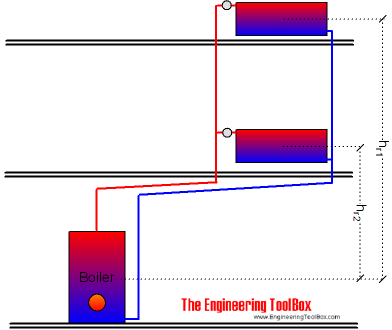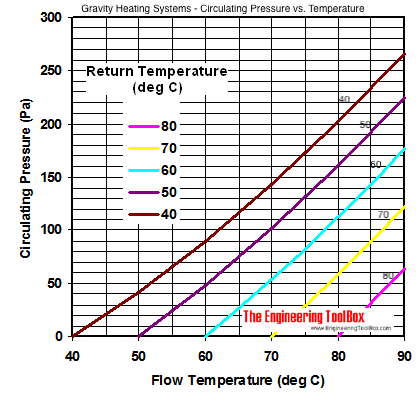Gravity Heating System
The density difference between hot and cold water is the circulating force in a self circulating gravity heating system.
A self circulation heating system operates by the force created by the density difference between hot and cold fluid.

Gravity Head
The head forcing circulation through a gravity system is proportional to the elevation - he - of the heating elements (or radiators) above the boiler, and the temperature difference between the flow and return pipe lines.
The head available for circulation can be calculated
hl = hr (ρr - ρf) / ((ρr + ρf) / 2) (1)
where
hl = head available for circulation (m, ft)
hr = height of radiator or heating element above boiler (m, ft)
ρf = density of water in flow (hot) pipe (lb/ft3, kg/m3)
ρr = density of water in return (cold) pipe (lb/ft3, kg/m3)
The thermal expansion of water is approximately 4.2% from 4 oC to 100 oC.
Converting Head to Pressure
Head units can be converted to pressure units as
p = hl ρ g (2)
where
p = pressure (Pa, N/m2) - Other units?
ρ = density (kg/m3) (using hot or cold density has little impact in this calculation)
g = acceleration of gravity (9.81 m/s2)
Circulating Pressure - Flow and Return Temperature
The forcing pressures in self circulation system with operating temperatures between 50 to 95 oC are indicated in the diagram and table below.

| Return Temperature (oC) | Circulating Pressure in Pa (N/m2) per m circulating elevation - he | |||||
|---|---|---|---|---|---|---|
| Flow Temperature (oC) | ||||||
| 40 | 50 | 60 | 70 | 80 | 90 | |
| 90 | 0 | |||||
| 80 | 0 | 64 | ||||
| 70 | 0 | 59 | 123 | |||
| 60 | 0 | 54 | 113 | 177 | ||
| 50 | 0 | 48 | 101 | 161 | 225 | |
| 40 | 0 | 41 | 89 | 143 | 203 | 267 |



